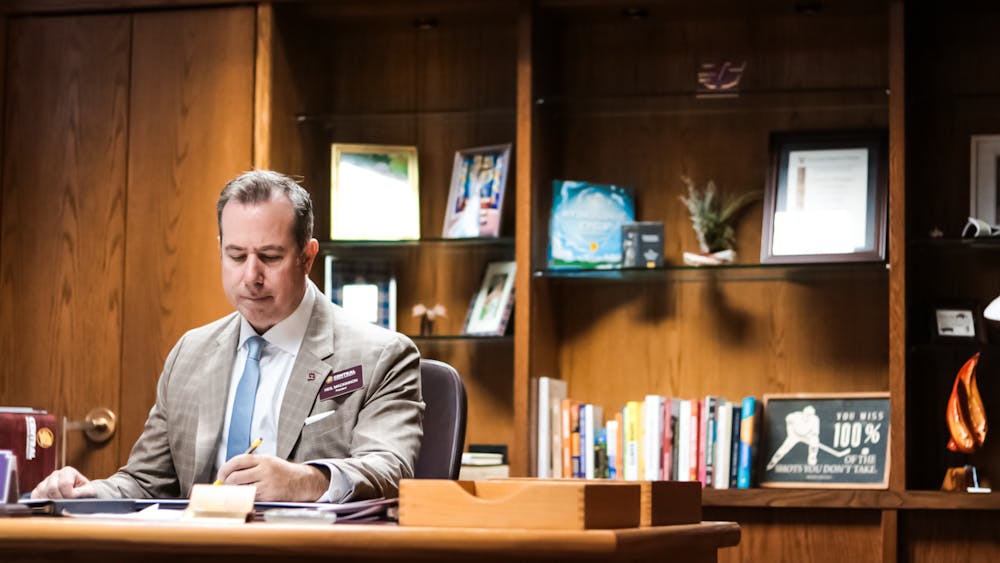EDITORIAL: Central Michigan University celebrates its 125th anniversary, students should look to the past when considering their futures
Respect, charity, activism can guide CMU into the next 125 years

How much do you really know about Central Michigan University?
Did you know our mascot used to be the Dragons, then the Bearcats before we became the Chippewas? Or that Muhammad Ali, Amelia Earhart and President William Howard Taft all visited campus? How about how we got the catchphrase "Fire Up Chips"?
This year CMU celebrates its 125th anniversary and we all should look back at its long and storied history to learn from the past and make a better future for our campus.
In our time browsing Clarke Historical Library, we noticed several things throughout CMU’s history that still hold true for today's students, beginning with our relationship with the Saginaw Chippewa Indian Tribe.
Our name, the Chippewas, began in December 1941 when football coach Doc Sweeney wanted a new mascot. He argued no student had ever seen or heard of a bearcat. The name stuck for several generations without consultation with the tribe, resulting in CMU using racist imagery to portray the tribe.
Our relationship, to put it mildly, wasn't great.
Fast forward to 2005, the tribe gave its explicit support to continue use of the name Chippewa — with modifications. We now educate students on the proper use of game day face paint, advise them to not wear headdresses at games and discourage war cries and tomahawk chopping in Kelly/Shorts Stadium.
We also should continue to be charitable, just as we've always been.
In 1960, a group of student veterans of the Korean War formed the Korean Orphanage Committee, dedicated to raising funds for the Mun San Orphanage in Korea. Efforts continued well into the 1970s. Children of that orphanage grew up and reached out to those CMU students who cared about them countries away. They were able to meet their benefactors. Those students were able to make a difference in many peoples' lives.
We see that same spirit today with student driven philanthropic funds like the Keisha Y. Brown Angel Wings Fund, dedicated to raising money for children who lost parents to cancer, and the Derrick Nash Strong Foundation. When it comes to buying a parking pass, students might be stingy. When it comes to helping each other or the community, we've always been generous with our time and support.
Sometimes, fundraising isn't enough and the time comes to be vocal about your support or disapproval of something. Protesting at CMU isn't a new fad: it's a part of our campus blood.
In 1962, there were disagreements between students and the school’s administration regarding student rights at the university. The disagreements grew to the point that students marched from campus to CMU’s president’s house to demand fair treatment on campus.
Students participated in the 1969 Moratorium to End the War in Vietnam. Our own university president at the time, William Boyd, even marched alongside students.
The chairman of our Board of Trustees issued a direct statement to President Richard Nixon saying, "It would be a tragedy if our young people did not react at all to this sad affair (of the Vietnam War). The very foundation of our democracy is an enlightened, alert, questioning populace. There would be something wrong with (students) if they accepted Vietnam blandly, complacently and without question."
In response to the U.S. invasion of Cambodia and the death of students at Kent State University, CMU students occupied Central Hall which was where our ROTC building was stationed. Instead of calling in police, again President Boyd was supportive and let the student protests dissipate on their own.
Today, we've seen students protesting the election of President Donald Trump, the president's immigration ban from seven predominantly Muslim countries and being vocally supportive of a Gender and Sexuality Center on campus.
Protesting isn't something new to CMU and it's not something reserved for "snowflakes" in search of "safe-spaces." It's something cemented in our history as an action to be proud of.
As we look back on our history, we encourage other students to do the same for CMU's 125th anniversary. An easy way to do this is to look at the timeline the Clark Historical Library created on its website. Going over CMU’s history can help us see what made the last 125 years successful.
Let's make sure the next century of CMU is even greater.






